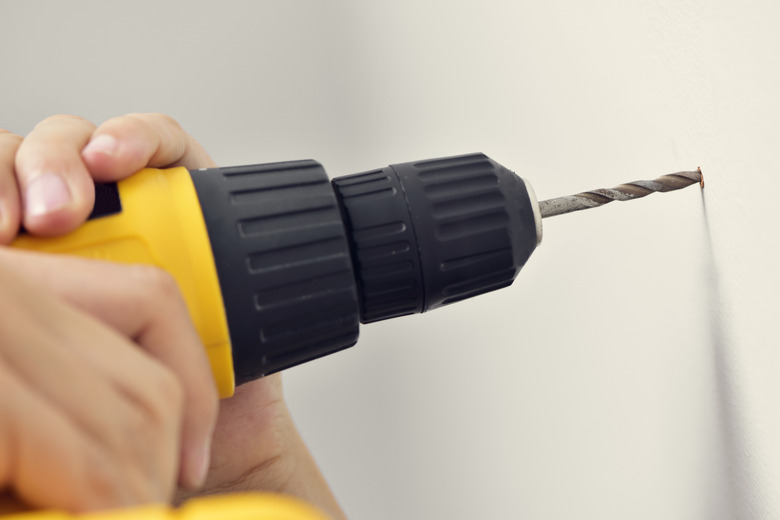What Size Drill Bit To Use With Wall Anchors
We may receive a commission on purchases made from links.
By itself, drywall won't hold a screw, so if you want to attach anything to the wall or hang anything heaver than a few pounds, you need to install a wall anchor to hold the screw. The drill bit size for the anchor depends not only on the size of the anchor, but on its type: Anchors manufactured for lightweight applications typically need the use of a 1/4 to 3/8 inch drill bit, while toggle-type anchors for heavy duty use may need a 1/2 inch drill bit or even larger to accommodate the toggles or wings. No matter which wall anchor you choose, never exceed the weight limits on the package.
Before you start to drill, learn more about the proper drill bit size and each type of wall anchor.
Plastic Expansion Anchors
Plastic Expansion Anchors
Plastic expansion anchors are used for hanging light- to medium-weight items on drywall and hollow core doors. The anchor is installed, then the screw is inserted into the anchor. As the screw is screwed in, the anchor expands in and/or behind the drywall to hold a lightweight picture or decorative item in place.
You know the hole for a conical plastic anchor is the right size if you have difficulty pushing it in — you may have to tap it gently with a hammer. If it takes more than a few taps, consider using the next size up drill bit to avoid damaging the plastic anchor.
To determine the right-size hole for a plastic wall anchor, remember the following:
- Measure the shank of the drill bit against the front of the anchor — its diameter should be the same size or 1/16 inch more than that to make the opening for the screw.
- If the diameter of the anchor is displayed on the packaging, drill the hole with a bit of the same diameter.
- Don't exceed the weights indicated on the package or your picture or collectable décor may pull the anchor out and end up on the floor.
Self-Drilling Wall Anchors
Self-Drilling Wall Anchors
Some wall anchors are manufactured to self-drill or self-tap into drywall. These plastic or metal anchors are useful for medium-weight items, such as heavier picture frames or mirrors.
Although the package usually states you can just drill the anchor into the wall, you can make it easier by breaking through the paint and paper or wallpaper with a nail and then pulling it out, or drilling a small pilot hole. Then, insert a drill bit into the head of the anchor and drill it into the wall before adding the screw.
Heavy-Duty Wall Anchors
Heavy-Duty Wall Anchors
Metal or plastic anchors with expanding toggles or wings can hold heavier weights and don't have to fit as snugly in the hole. The diameter of the hole you need is determined by the diameter of the anchor sleeve; measure it with a ruler when the wings are folded as closely to the sleeve as possible and use a bit with that diameter. Alternatively, there are heavy-duty self-drilling toggle anchors made for use with drywall.
The size of the hole varies according to the product, but generally range from 1/2-inch up to 3/4-inch or more. A toggle bolt that can hold up to 70 pounds or more will need a larger hole to accommodate the larger toggles, which distribute the weight over a larger area behind the drywall. When installing a very heavy item on a wall, such as a TV or a microwave, locate the studs with a stud-finder and try to ensure that at least one side of the mount is attached to a stud to make sure that your TV or microwave stays attached to the wall.
Tip
Don't want to drill a hole in the wall and need to hang up a heavy object? Try using a monkey hook, which is a simple-to-use product that simply pushes in the wall and can hold up to 50 pounds.
